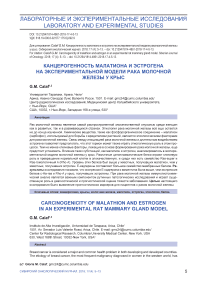Carcinogenicity of malathion and estrogen in an experimental rat mammary gland model
Автор: Calaf Gloria M.
Журнал: Сибирский онкологический журнал @siboncoj
Рубрика: Лабораторные и экспериментальные исследования
Статья в выпуске: 4 т.17, 2018 года.
Бесплатный доступ
Breast cancer is considered a major and common health problem in both developing and developed countries. The etiology of breast cancer, the most frequent malignancy diagnosed in women in the western world, has remained unidentified. Chemicals as the organophosphorous pesticide malathion have been used to control a wide range of sucking and chewing pests of field crops, and are involved in the etiology of breast cancers. The association between breast cancer initiation and prolonged exposure to estrogen suggests that this hormone may also have an etiologic role in such a process. However, the key factors behind the initiation of breast cancer remain to be elucidated. The effect of environmental substances, such as malathion and estrogen was analyzed in an experimental rat mammary gland model. Different cytoplasmic proteins are key in the transformation of a normal cell to a malignant tumor cell and among these are the Ras super family and Ras homologous A (Rho-A). both types of proteins were greater in animals treated with malathion than those with estrogens. E-Cadherins constitute a large family of cell surface proteins. results showed greater expression of E-Cadherin and vimentin than c-Ha-ras and Rho-A in rats treated by estrogens. In breast cancer, analysis using immunohistochemical markers is an essential component of routine pathological examinations, and plays an important role in the management of the disease by providing diagnostic and prognostic strategies. the aim of the present study was to identify markers that can be used as a prognostic tool for breast cancer patients.
Carcinogenesis, rat, mammary gland, malathion, estrogen, etiology, proteins
Короткий адрес: https://sciup.org/140254199
IDR: 140254199 | DOI: 10.21294/1814-4861-2018-17-4-5-13
Список литературы Carcinogenicity of malathion and estrogen in an experimental rat mammary gland model
- Perera F.P. Environment and cancer: who are susceptible? Science. 1997; 278(5340): 1068-1073.
- Cabello G., Valenzuela M., Vilaxa A., Duran V., Rudolph I., Hrepic N., Calaf G. A rat mammary tumor model induced by the organophosphorous pesticides parathion and malathion, possibly through acetylcholinesterase inhibition. Environ Health Perspect. 2001 May; 109(5): 471 9.
- Knower K.C., To S.Q., Leung Y.K., Ho S.M., Clyne C.D. Endocrine disruption of the epigenome: a breast cancer link. Endocr Relat Cancer. 2014 Mar 12; 21(2): T33 55. DOI: 10.1530/ERC-13-0513
- IARC. IARC working group on the evaluation of carcinogenic risks to humans. IARC Monogr Eval Carcinog Risks Hum. 1994; 61: 45 119.
- Guyton K.Z., Loomis D., Grosse Y., El Ghissassi F., Benbrahim-Tallaa L., Guha N., Scoccianti C., Mattock H., Straif K.; International Agency for Research on Cancer Monograph Working Group, IARC, Lyon, France. Carcinogenicity of tetrachlorvinphos, parathion, malathion, diazinon, and glyphosate. Lancet Oncol. 2015 May; 16(5): 490 1. DOI: 10.1016/S1470-2045(15)70134-8


